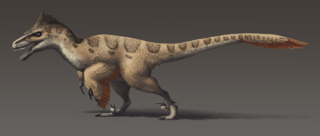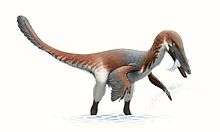Dromaeosaurinae
| Dromaeosaurines | |
|---|---|
 | |
| Artist's restoration of Utahraptor ostrommaysorum | |
| Scientific classification | |
| Kingdom: | Animalia |
| Phylum: | Chordata |
| Clade: | Dinosauria |
| Order: | Saurischia |
| Suborder: | Theropoda |
| Family: | †Dromaeosauridae |
| Clade: | †Eudromaeosauria |
| Subfamily: | †Dromaeosaurinae Matthew & Brown 1922 |
| Type species | |
| Dromaeosaurus albertensis Matthew & Brown 1922 | |
| Genera | |
Dromaeosaurinae is a subfamily of Dromaeosauridae. Most dromaeosaurines lived in what is now the United States and Canada, as well as Mongolia, and possibly Denmark as well. Isolated teeth that may belong to African dromaeosaurines have also been discovered in Ethiopia. These teeth date to the Tithonian stage, of the Late Jurassic Period.[1]
All North American and Asian dromaeosaurine dinosaurs from the Late Cretaceous were generally small, no more than 1.8 metres (5.9 ft) long, in Dromaeosaurus and Adasaurus. However, among the dromaeosaurines were the largest dromaeosaurs ever; Dakotaraptor was ~5.5 metres (18 ft) long, Achillobator 6 metres (20 ft), and Utahraptor up to ~7 metres (23 ft).
Classification and phylogeny
Dromaeosaurines are distinguished from other dromaeosaurids in having stouter, box-shaped skulls, as opposed to the other subfamilies, which generally have narrower snouts. Also, dromaeosaurines are generally more heavily built, than the other members of their family, with thick, heavy-set legs, which were designed more for strength, rather than for speed.
Also, dromaeosaurines are distinguished from velociraptorines, in having a low DSDI ratio; i.e., their teeth have equal-sized serrations, on both the posterior and on the anterior edges. By contrast, velociraptorines often have larger serrations on the posterior side of the tooth, than the anterior, or no serrations on the anterior side at all.
Most dromaeosaurines lived during the Cretaceous period, from the Barremian to the Maastrichtian stages. However, as stated previously, at least one taxon must have lived much earlier, during the Jurassic Period.
The cladogram below follows a 2015 analysis by paleontologists Robert DePalma, David Burnham, Larry Martin, Peter Larson, and Robert Bakker, using updated data from the Theropod Working Group.[2]
| Eudromaeosauria |
| ||||||||||||||||||||||||||||||||||||||||||
See also
References
- ↑ Goodwin, Clemens, Hutchinson, Wood, Zavada, Kemp, Duffin and Schaff (1999). "Mesozoic continental vertebrates with associated palynostratigraphic dates from the northwestern Ethiopian Plateau." Journal of Vertebrate Paleontology, 19(4): 728-741.
- ↑ DePalma, Robert A.; Burnham, David A.; Martin, Larry D.; Larson, Peter L.; Bakker, Robert T. (2015). "The First Giant Raptor (Theropoda: Dromaeosauridae) from the Hell Creek Formation". Paleontological Contributions (14).
External links
| Wikispecies has information related to Dromaeosaurinae |

